It might appear strange to see Eintracht Frankfurt Frauen sitting second in the Frauen-Bundesliga standings at the present time, behind only defending champions Bayern Munich Frauen, but it is not an entirely unexpected position for them to be in.
Niko Arnautis’s side has been a formidable outfit in recent times.
They finished third in each of the last three German top-flight campaigns, so they are absolutely not a team to underestimate.
One of the main reasons for that has been the quality of their squad, with Frankfurt possessing some outstanding names in their ranks.
All of them have contributed to their strong form at the beginning of this campaign and deserve credit for their efforts.
However,
many have picked out Laura Freigang as the heart of everything they do well. The Germany international isconsidered by many to be the best player in the league at this moment in time.
Capable of operating as either a forward or as a withdrawn attacker, she currently leads the goalscoring charts with seven to her name, but it is her wider contributions that have led to such praise.
With that in mind, this tactical analysis will examine what
Laura Freigangbrings to Frankfurt’s table and why she has become such an irreplaceable asset as they seek to extend their stay at the top of the German women’s game.
Laura Freigang’s Attacking Threat
Whilst Laura Freigang’s position for Frankfurt has evolved as each season has gone on, she is undoubtedly an attacker first and foremost and has a permanent eye for goal.
Under Niko Arnautis’s style of play, Frankfurt has been kept to utilise this, with Freigang being the predominant focal point of his side’s offensive play this season and averaging 9.25 touches inside the penalty area.
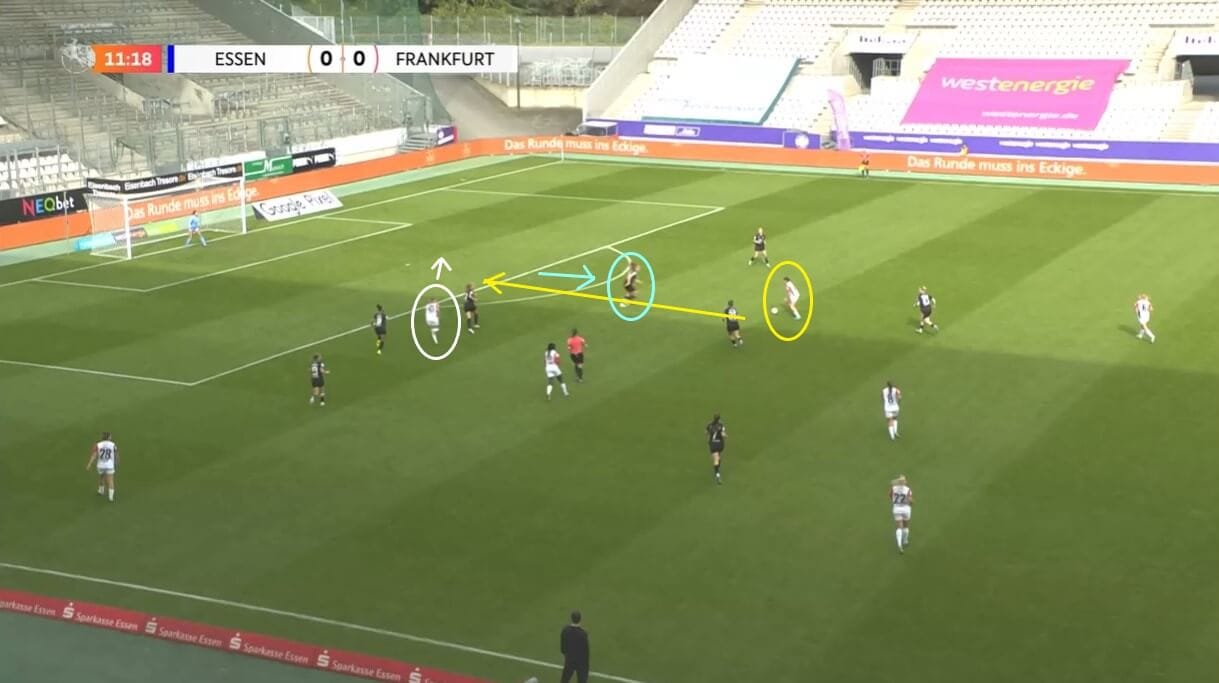
Her ability to get into advanced areas and to create problems for opposing backlines comes down in many ways to her identification of space, with one of her key strengths being to find gaps and to punish mistakes that Frankfurt’s opponents commit.
This was one clear example.
It initially appeared as though Essen Frauen had done enough to keep Frankfurt out, but defender Laura Pucks’s split-second decision to close Switzerland forward Géraldine Reuteler down opened space.
That was all the invitation that Freigang needed.
As can be seen, she has made a diagonal run into the gap that has appeared and has offered Reuteler a passing option into the open territory behind the Essen line, which would not have been possible without Pucks’ error or Freigang’s ability to take advantage of it.
On this occasion, the chance didn’t materialise into anything as Essen did manage to recover well and prevented the error from being a costly one, but it was a warning with regards to the way that Frankfurt only needed one misjudgement to break through opposing lines.
It also clearly demonstrated how dangerous Freigang is whenever spaces open up and why she is a player who needs to be watched closely at all times.

In addition to her spatial awareness, Freigang’s movement has also made her such an effective goal threat.
She regularly timing runs to perfection in order to stay onside and not receive the ball in situations where she does not have the upper hand.
This was one moment in which that was evident, with Frankfurt making their way into Freiburg Frauen’s third and looking to send the ball into the goal area through Reuteler.
Freiburg, to their credit, have got numbers back to make her task as difficult as possible.
However, what they have not realised is that Freigang has taken a few steps back from left wing-back Lisa Karl and has, therefore, created an element of surprise in her team’s favour.
This allows her to reach the ball first and turn it into the back of the net, with Freiburg unable to react because they simply did not read her intentions.
This shows once again how dangerous Freigang is to leave unattended with space to run into.
There is an argument that Freiburg was the architect of their own downfall because they turned their backs on her, which is certainly true.
Still, Freigang’s giving herself additional space and timing her run well were also critical to achieving the goal.
Therefore, her ability to provide a significant offensive threat needs to be factored into the equation.
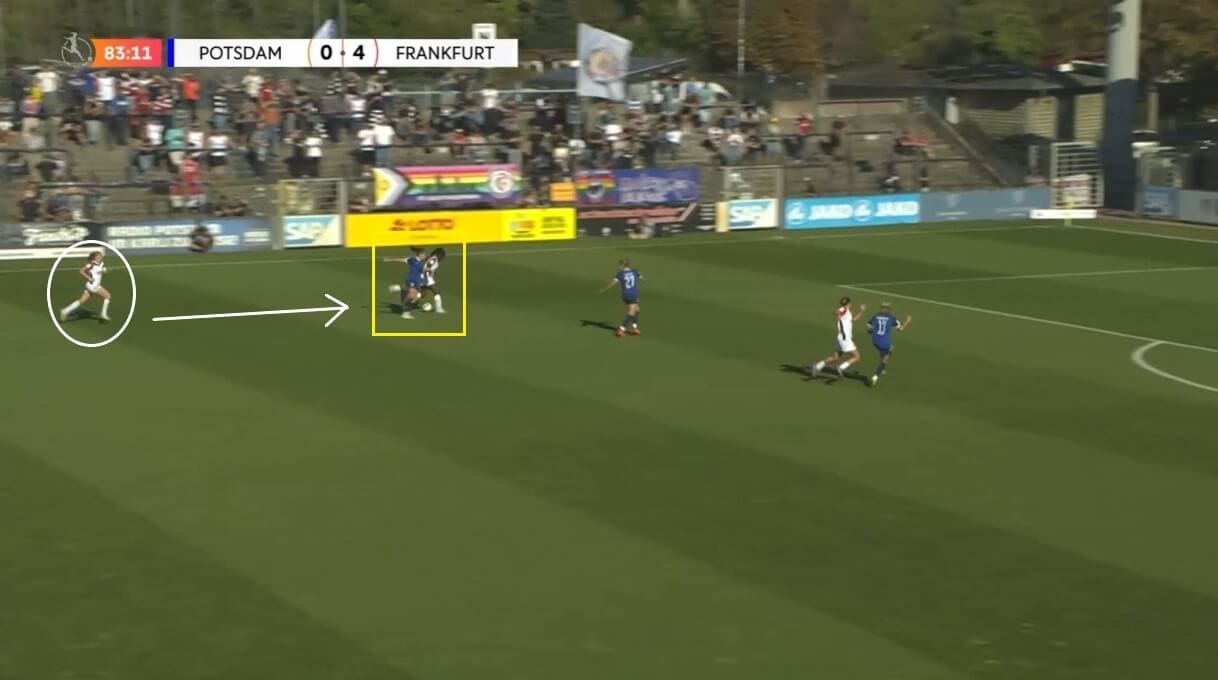
As mentioned at the beginning of this scout report, though, Freigang has not solely been tasked with leading the line and has instead, more often than not, operated behind the first line of attack.
This, too, has really benefitted her and her team, giving her licence to sit in gaps and to affect the game through the same spatial awareness that she has shown when further up the field.
Having her in a withdrawn role has given Frankfurt this dynamic, with Nicole Anyomi and another (mainly Reuteler this season) using their natural pace to punch holes in opposing defensive lines, whilst Freigang has then provided a secondary threat.
It has showcased her ability to change direction when needed, adapt to what is happening ahead of her, and constantly offer support where it is required.
In this case, she recognised that Anyomi had come under pressure from Turbine Potsdam defender Emilie Bernhardt and that she was slowing down, so Freigang sprinted past her and provided a way of continuing the attack.
With Potsdam’s focus on Anyomi’s initial attack, they were unable to react to that pass in time, and Freigang had Brandenburg’s freedom to control the ball and find the back of the net.
Therefore, Freigang has tested opposing back lines not only when she is part of the initial attack, and that has given Niko Arnautis tactically a lot of flexibility this season regarding where he deploys her.
Laura Freigang’s Freedom To Roam
However, Laura Freigang’s ability to roam in spaces has not only allowed her to monitor those teammates in front of her, but there are other reasons that Frankfurt has come to depend on it in recent times.

One of those is her tendency to make horizontal as well as vertical movements.
She is constantly alert to what is happening on the wings and moves into those channels whenever she senses an opportunity to use them to Frankfurt’s advantage.
This was one of those moments.
She recognised that Freiburg had once again left themselves vulnerable on the right-hand side due to players not tracking back in time, and she, therefore, moved to occupy that space.
It should be mentioned that midfielder Selina Vobian was racing to get back here and fill in, but she could not reach the back line before Freigang had shifted across.
This extends the play and makes it much harder for Freiburg to contain the offensive move, as they need to monitor more of the pitch.
Freigang’s clever identification of space and the structural freedom she operates with is the key to this.
It also gives her options when the ball does arrive at her feet, with her able to dribble towards the goal line and look for a cross or cut back inside and try to fashion an opportunity for herself.
Ultimately, she opted for the latter here and successfully evaded attempts by Vobian, Samantha Steuerwald and Austrian midfielder Nicole Ojukwu to halt her progress.
Her subsequent pass towards Reuteler might have lacked accuracy on this occasion, but the fact that she scored from a similar position just a short while later indicates that she poses just as significant a threat from these areas as she does from more central spaces.
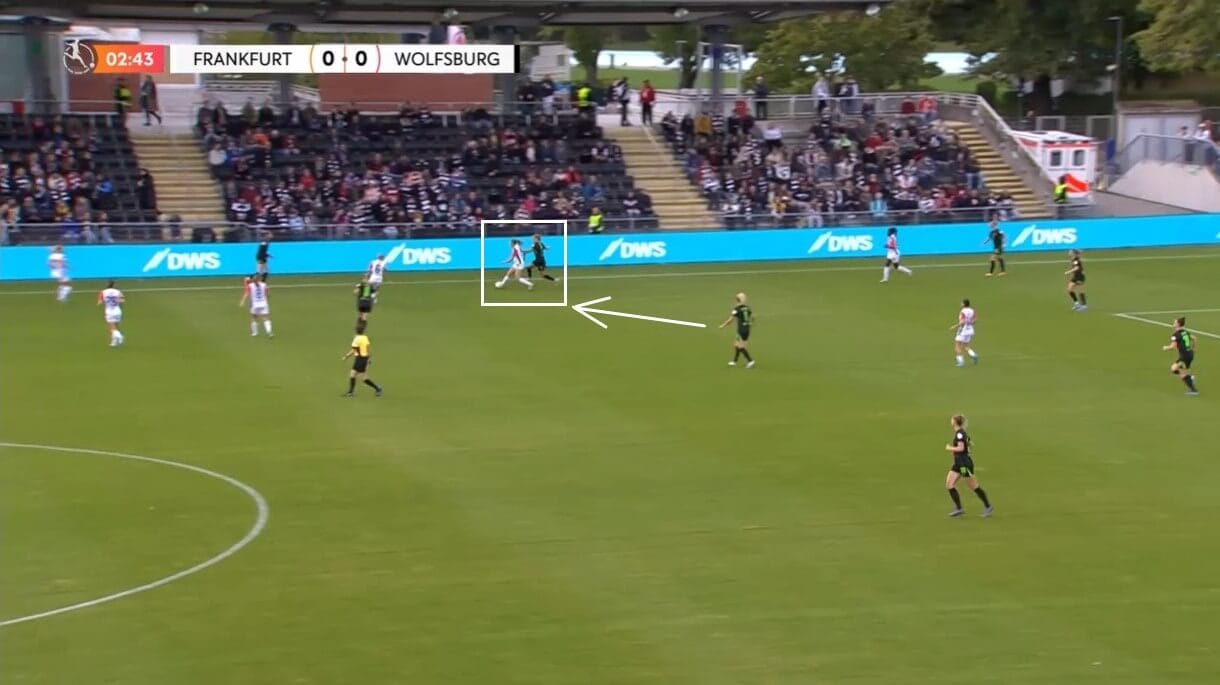
The fact that she has such a free role also allows her to react quickly and to regain the ball whenever her team lose it, which highlights yet another aspect of her play that has made her such an effective name for her team.
In this situation, Wolfsburg Frauen have looked to play out from the back and have shifted the ball into the path of Lynn Wilms, but the Netherlands right-back is unable to gain too much momentum due to Freigang tracking and closing her down at speed.
Any attacker’s skill set must include the ability to defend on the front foot, but it was especially important against Wolfsburg.
The Bundesliga giants might have had a poor campaign last time out and have encountered mixed performances in the opening stages of the current one as they adjust to key summer departures (such as Poland striker Ewa Pajor, who joined Barcelona Femení; Germany midfielder Lena Oberdorf, who linked up with rivals Bayern Munich; and Netherlands defender Dominique Janssen, who made the switch to Manchester United Women), but they have shown an ability to connect the dots when there has been an opportunity for them to do so.
As a result, ending their attempts to construct attacks in situations such as this will always be critical, and this was one reason that Frankfurt scored three goals without replying against them.
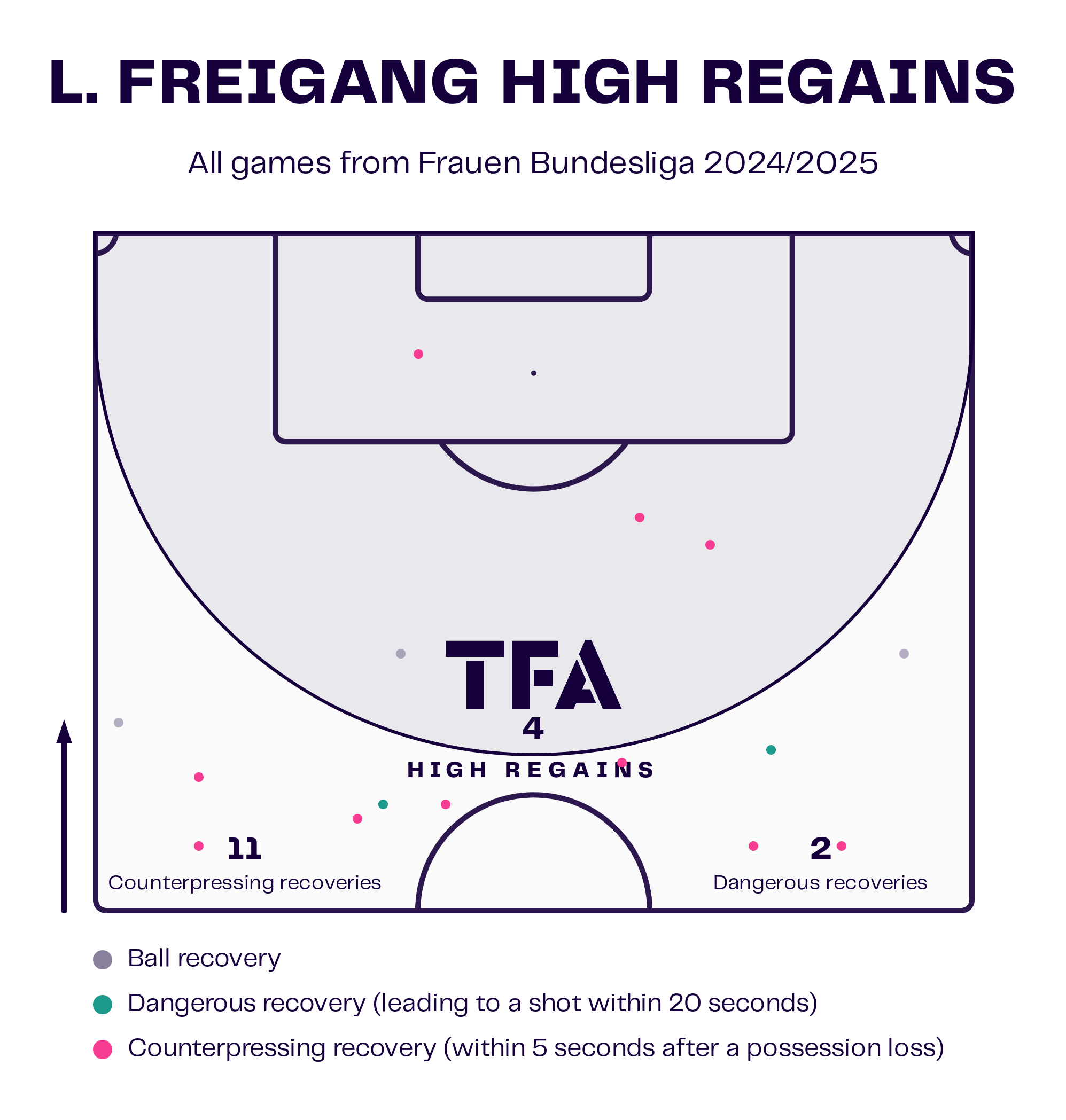
It should be mentioned that that press was not a one-off from Freigang.
Instead,
she has done a lot during the opening stages of the campaign, succeeding in eight of the 16 defensive duels that she has engaged in so far and making severalattempts to regain the ball high up the pitch.
This graphic shows how many times she has sought to prevent opposing sides from gaining too much territory.
The fact that she has regained possession in every possible channel once again indicates the benefits that her positional freedom brings.
Overall, it certainly adds to the picture being painted of how much she offers Frankfurt, both with and without the ball, and how she does a lot more than some perhaps give her credit for.
Laura Freigang’s Link-Up Play
The theme of Laura Freigang working hard for the team continues when she breaks down how she links play for her team.
She not only gets into areas where she can score but also where she can play the supporting role.
She has thrived at this, too, with her 80% accuracy for passes into the penalty area so far.
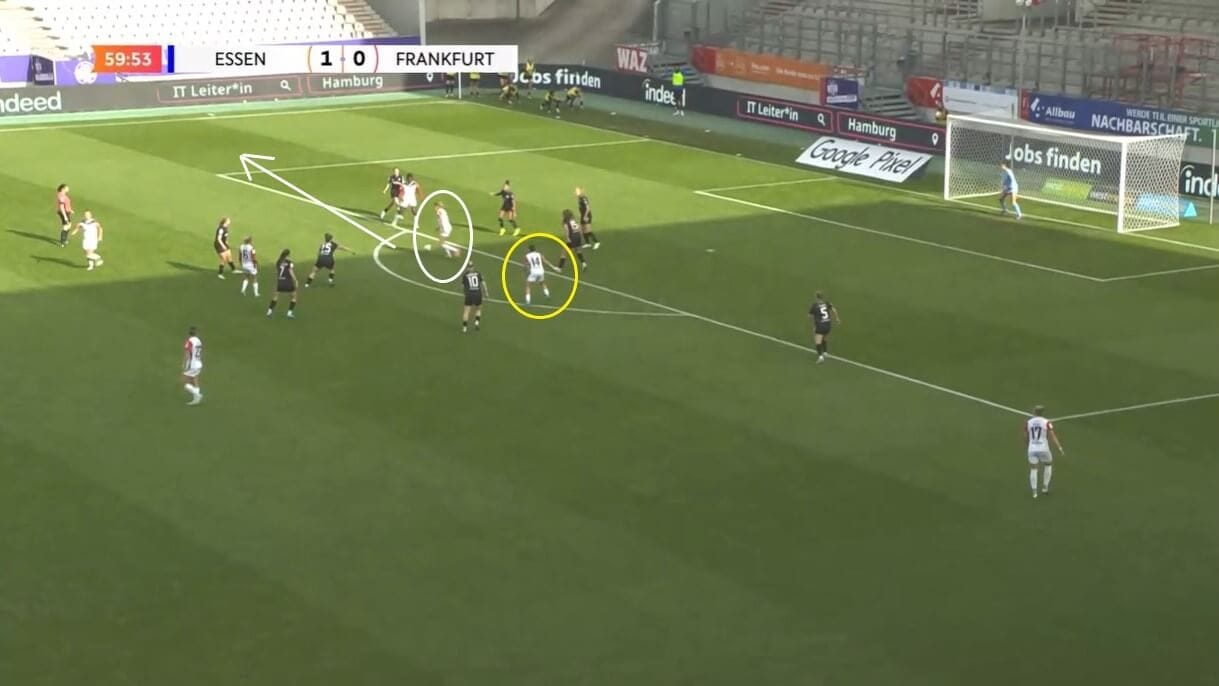
As with most points
in this analysis, her withdrawn forward positioning aids her ability to pull the strings. She also understands when to set up a shot on goal and whento show more patience.
In this case, she was on the edge of the Freiburg goal area and had Reuteler outside her and in a position to shoot at goal, but the tight angle that she would have needed to turn in made it a risky option, so she shifted the ball out towards the far side wing instead.
Some might see Frankfurt and Freigang as too tricky in their build-up play, and this is not an unreasonable observation.
However, as it is common for teams to rush opportunities and see them break down prematurely, having players who can recognise when it is the right time to make those passes is invaluable.
The fact that Freigang scored only a few phases later when former Bayer Leverkusen Frauen midfielder Elisa Senß’s shot arrived at her feet showed how, on this occasion, at least, it was the right approach to take.
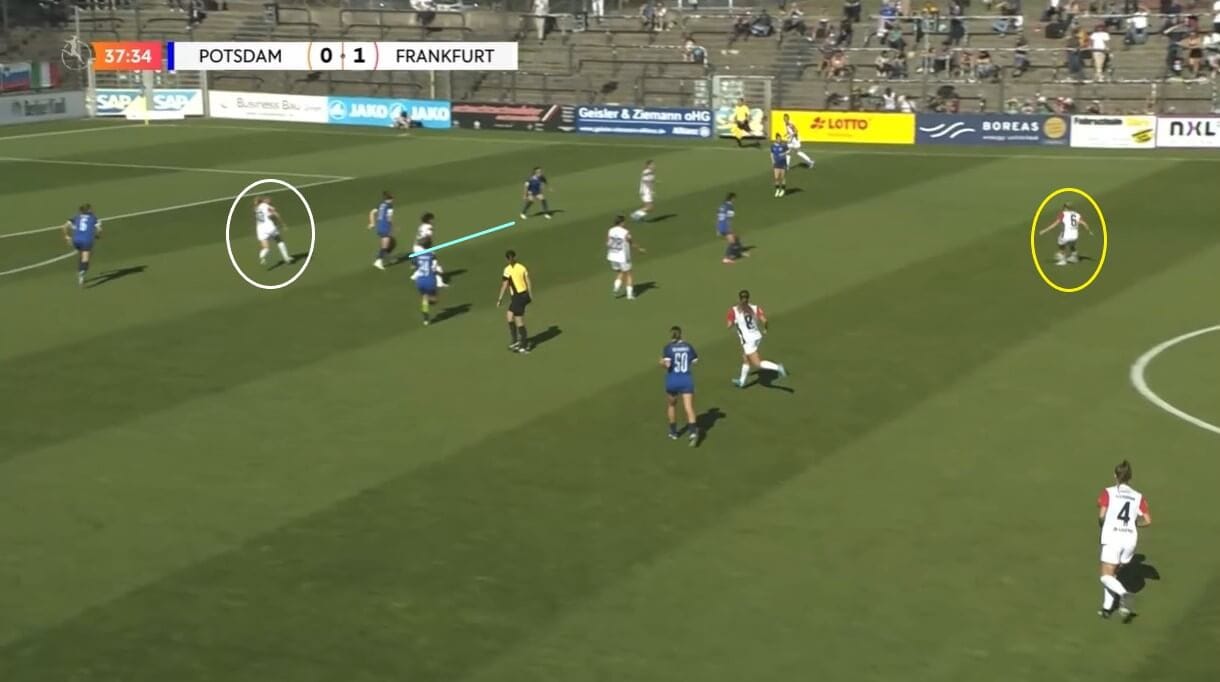
There have been times when Frankfurt have tried to combine that ability to be a pivot point with her aforementioned desire to break behind defensive lines, with the match against the returning Potsdam (whose spell outside of the top flight lasted just a single season) one match in which that formed the basis of NiKo Arnautis’s tactics.
Arnautis recognised that his side’s rivals would likely sit back and try to frustrate his team’s ability to create clear-cut opportunities, and so his game plan on the day revolved around fashioning gaps that could be used to Frankfurt’s advantage.
It was a system that relied heavily on Freigang moving up the field, as she has done here by getting behind Bernhardt and Japanese player Sara Ito, but not turning and running towards the goal as she would have done in other outings.
Instead, she turned towards her team and focused on holding the ball up.
Her aim was to force the Potsdam players to take a step towards her and leave spaces open further back for her teammates to make advances.
On this occasion, the strategy worked perfectly.
Senß sent the ball into her path, and Swiss defender Mia Schmid challenged her. Potsdam instantly dropped back and relinquished control of the territory that they had previously been in.
As a result, Senß, Austrian playmaker Barbara Dunst, and others were able to get closer to the Potsdam goal area and launch another passing sequence designed to gain them even more ground.
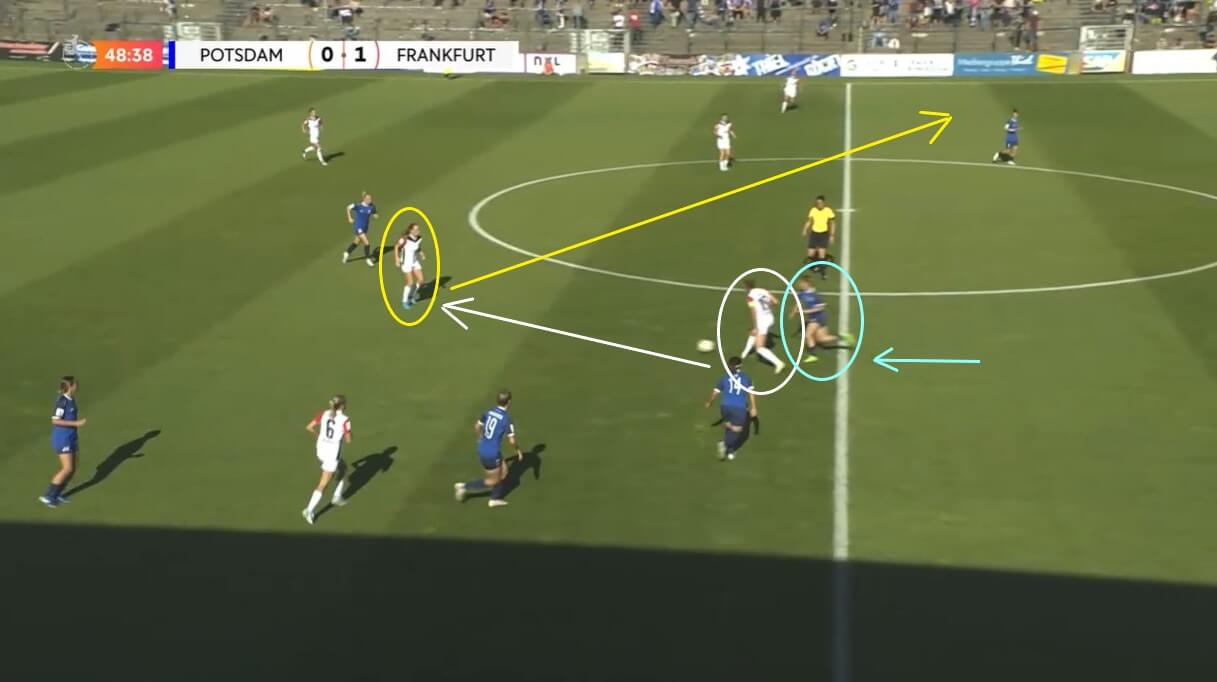
However, Freigang doesn’t only involve herself in build-up play once the ball enters the final third; she’s just as happy to drop into deeper areas when needed.
Frankfurt relies heavily on all of its players for this, with much of its success coming from its well-executed transitions and precise passing sequences.
Freigang’s 86.9% passing accuracy so far shows that this is another strength in her game.
In this case, she has dropped back to receive the ball from German defender Sara Doorsoun before instantly sending it back towards Lisanne Gräwe, but that is not the only thing that needs to be pointed out.
Instead, her movement enticing Potsdam midfielder Caroline Krawczyk into following her leaves a gap open behind and removes an obstacle that Frankfurt would have originally needed to negotiate.
As a result, when Gräwe shifts the ball out to the far side wing, there is more space for her to utilise and a better chance of the ball reaching its intended target.
Once again, it was a team effort, but there is no doubting the role that Freigang played in it, and that highlights again how she is happy to play the team game, lead the line, and be the main focal point.
This has made her an essential player for her team and one that many rate highly in the German women’s game.
Conclusion
In conclusion, this tactical analysis has examined Eintracht Frankfurt Frauen forward Laura Freigang’s style of play more closely, highlighting her role in their strong start to the 2024/25 Frauen-Bundesliga campaign and why she is regarded by many Bundesliga fans as the best player currently featured in it.
As has been highlighted throughout the analysis, what makes Freigang such a vital player for her team to have available is the way that she can bring so many different things to the table.
She has the goal threat that forwards should have and is clinical when she gets into dangerous areas, but she is also capable of providing chances for others and playing her part in making Frankfurt difficult to come across.
This is not to say that she is the perfect player, with there always being things that even the best player can improve upon, but there is no doubting her talent and quality and the fact that she is a player that other teams need to be wary of.

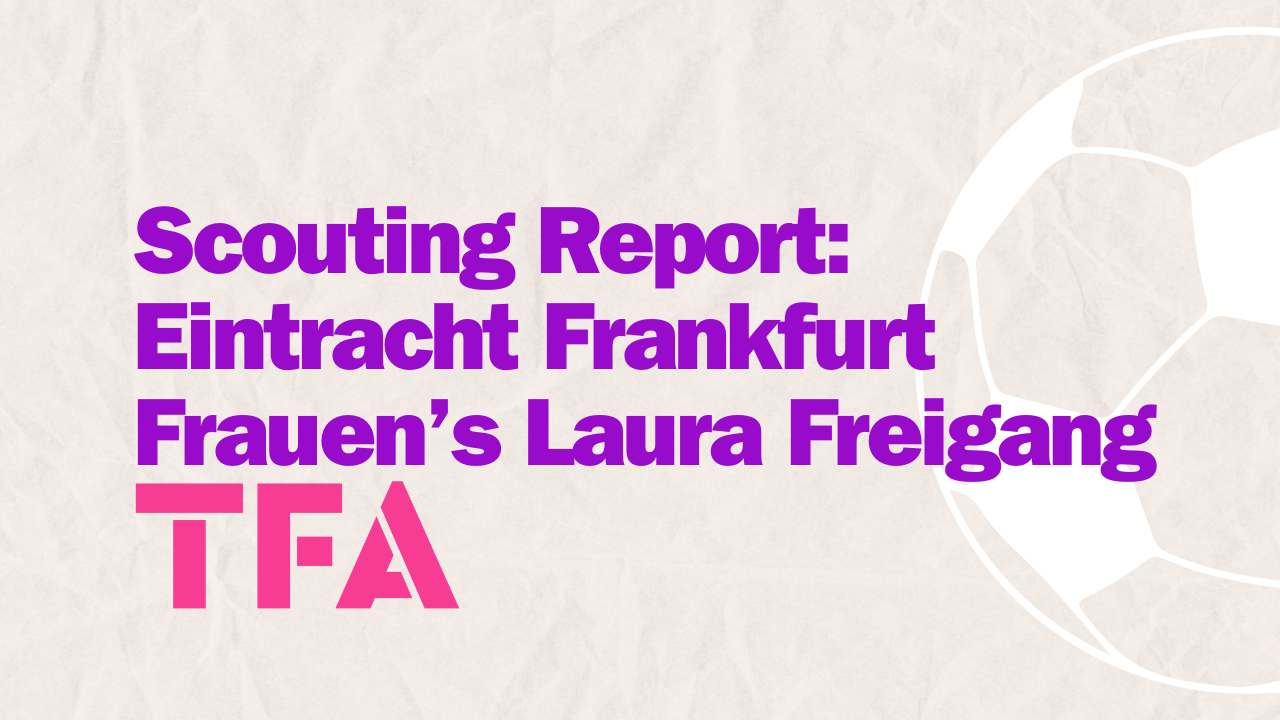



Comments